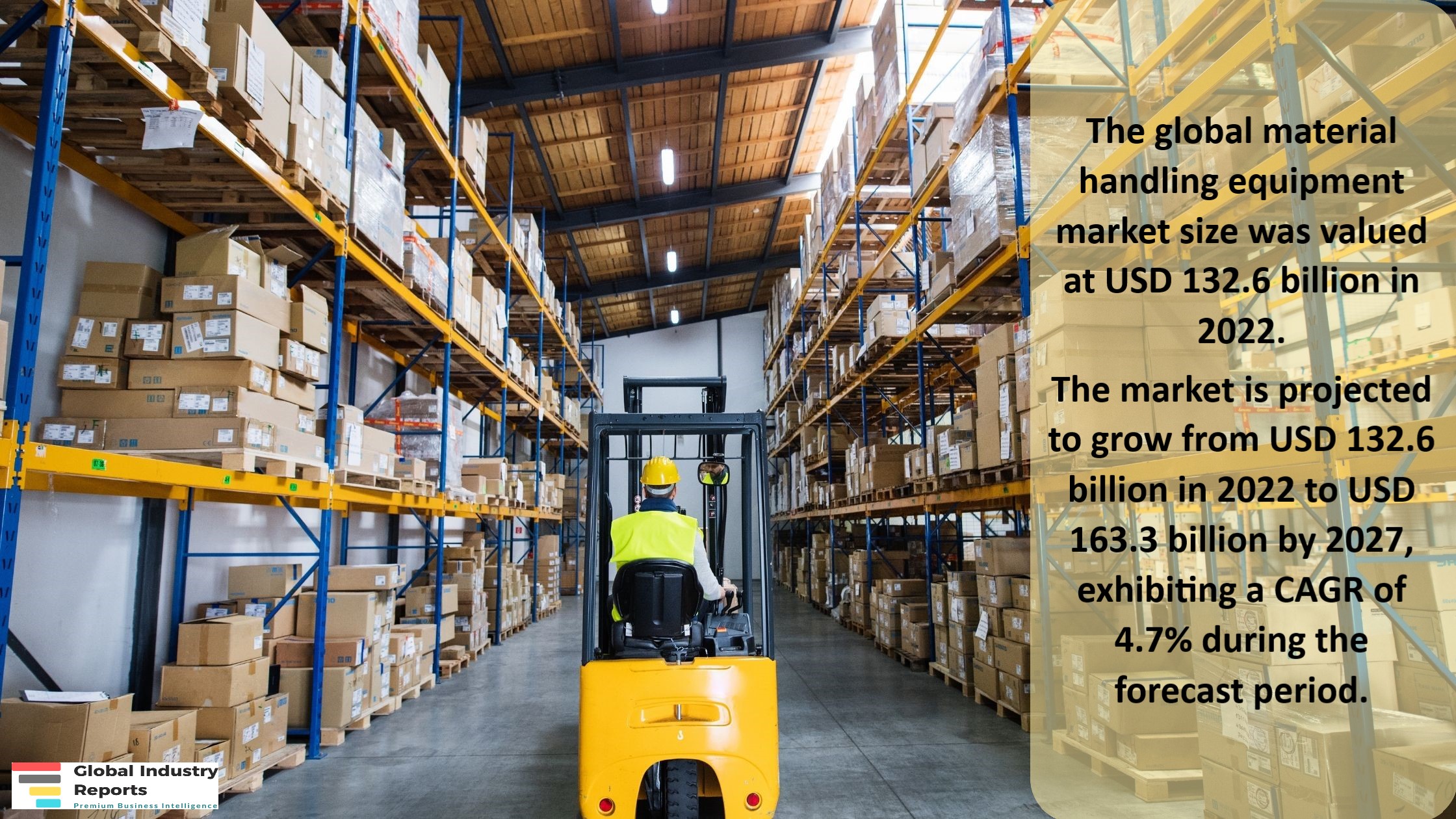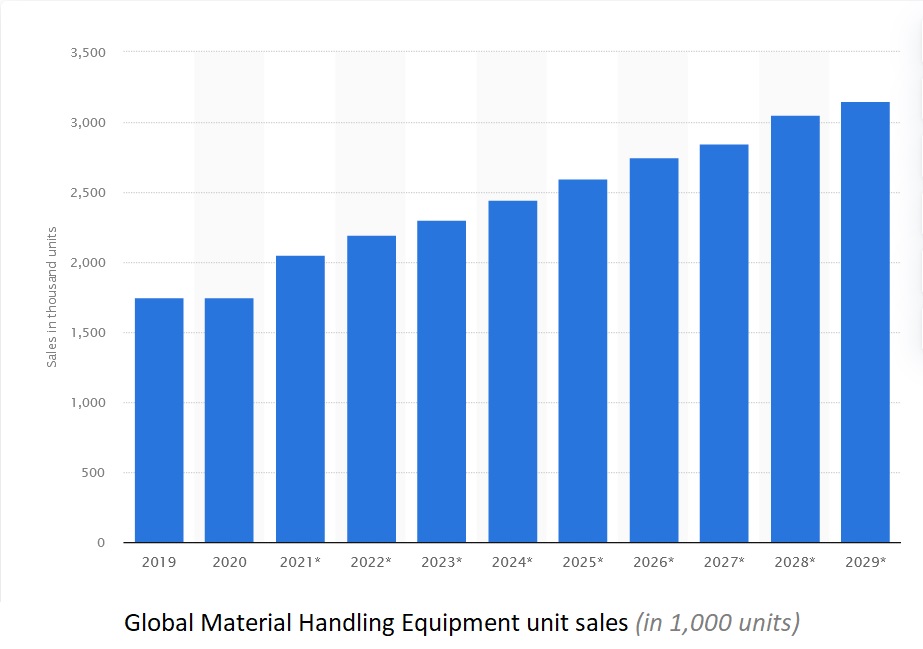Report Overview
- Understand the latest market trends and future growth opportunities for the Material Handling Equipment industry globally with research from the Global Industry Reports team of in-country analysts – experts by industry and geographic specialization.
- Key trends are clearly and succinctly summarized alongside the most current research data available. Understand and assess competitive threats and plan corporate strategy with our qualitative analysis, insight, and confident growth projections.
- The report will cover the overall analysis and insights in relation to the size and growth rate of the “Material Handling Equipment Market” by various segments at a global and regional level for the 2010-2028 period, with 2010-2021 as historical data, 2022 as a base year, 2023 as an estimated year and 2023-2028 as forecast period.
Description:
- The global material handling equipment market size was valued at USD 132.6 billion in 2022. The market is projected to grow from USD 132.6 billion in 2022 to USD 163.3 billion by 2027, exhibiting a CAGR of 4.7% during the forecast period.
- Conveyor Systems, one of the segments analyzed in the report, is projected to record a 4.3% CAGR and reach US$68.1 Billion by the end of the analysis period. Taking into account the ongoing post pandemic recovery, growth in the Forklifts segment is readjusted to a revised 5% CAGR for the next 7-year period.
- Based on our analysis, the global market exhibited an average growth of 4.5% in 2020 as compared to 2019. Material Handling Equipment (MHE) is a mechanical equipment used to transport, store, regulate, and protect materials, commodities, and outputs during the manufacturing, consumption, disposal, and distribution processes. Transportation equipment, positioning equipment, storage equipment, and others (unit load formation equipment, identification, and control equipment) are the four primary categories of material handling equipment available.

MARKET DATA INCLUDED
- Unit Sales, Average Selling Prices, Market Size & Growth Trends
- COVID-19 Impact and Global Recession Analysis
- Analysis of US inflation reduction act 2022
- Global competitiveness and key competitor percentage market shares
- Market presence across multiple geographies – Strong/Active/Niche/Trivial
- Online interactive peer-to-peer collaborative bespoke updates
- Market Drivers & Limiters
- Market Forecasts Until 2028, and Historical Data to 2015
- Recent Mergers & Acquisitions
- Company Profiles and Product Portfolios
- Leading Competitors

The Report Includes:
- The report provides a deep dive into details of the industry including definitions, classifications, and industry chain structure.
- Analysis of key supply-side and demand trends.
- Detailed segmentation of international and local products.
- Historic volume and value sizes, company, and brand market shares.
- Five-year forecasts of market trends and market growth.
- Robust and transparent research methodology conducted in-country.
- Qualitative and quantitative analysis of the market based on segmentation involving both economic as well as non-economic factors.
- Provision of market value (USD Billion) data for each segment and sub-segment.
- Analysis by geography, region, Country, and its states.
- A brief overview of the commercial potential of products, technologies, and applications.
- Company profiles of leading market participants dealing in products category.
- Description of properties and manufacturing processes.
- marketed segments on the basis of type, application, end users, region, and others.
- Discussion of the current state, setbacks, innovations, and future needs of the market.
- Examination of the market by application and by product sizes; utility-scale, medium scale and small-scale.
- Country-specific data and analysis for the United States, Russia, China, Germany, United Kingdom, France, Japan, Israel, Saudi Arabia, South Korea, United Arab Emirates, Canada, Switzerland, Australia, India, Italy, Turkey, Qatar, Sweden, Spain, Belgium, Netherlands, Norway, Singapore, Egypt, Denmark, Austria, Vietnam, Brazil, Argentina, Mexico, South Africa, and others.
- Coverage of historical overview, key industrial development and regulatory framework.
- Analysis of competitive developments, such as contracts & agreements, expansions, new product developments, and mergers & acquisitions in the market.
- A look at the opportunities in the market for stakeholders and provide a competitive landscape of the market leaders.
Reports Scope and Segments:
| Report Attribute | Details |
| Market size value in 2022 | USD 132.7 Billion |
| Revenue forecast in 2028 | USD 163.8 Billion |
| Growth Rate | CAGR of 18.5% from 2022 to 2028 |
| Base year for estimation | 2022 |
| Historical data | 2015 – 2021 |
| Forecast period | 2022 – 2028 |
| Quantitative units | Revenue in USD million and CAGR from 2022 to 2028 |
| Report coverage | Revenue forecast, company ranking, competitive landscape, growth factors, trends, DROT Analysis, Market Dynamics and Challenges, and Strategic Growth Initiatives
COVID-19 Impact, Market Growth Trends, Market Limiters, Competitive Analysis & SWOT for Top Competitors, Mergers & Acquisitions, Company Profiles, Product Portfolios, Disease Overviews. Market Size, Market Shares, Market Forecasts, Market Growth Rates, Units Sold, and Average Selling Prices. |
| Segments covered | Product, Type, Operation, Technology, Application, Region |
| Regional scope | North America; Europe; Asia Pacific; Latin America; Middle East and Africa and rest of the world |
| Country scope | United States, Russia, China, Germany, United Kingdom, France, Japan, Israel, Saudi Arabia, South Korea, United Arab Emirates, Canada, Switzerland, Australia, India, Italy, Turkey, Qatar, Sweden, Spain, Belgium, Netherlands, Norway, Singapore, Egypt, Denmark, Austria, Vietnam, Brazil, Argentina, Mexico, South Africa, and others. |
| Key companies profiled | Hytrol Conveyor Co., Inc.; Interroll Group; Invata Intralogistics; Invia Robotics; JBT Corporation; Jervis B. Webb Company; John Bean Technologies; Jungheinrich AG; Kion Group AG; Komatsu Ltd.; Konecranes; KUKU AG; Liebherr Group; Locus Robotics; Manitowoc; Mecalux, S.A.; Meiden America; Mitsubishi Caterpillar Forklift America, Inc.; Mitsubishi Logisnext Americas Inc.; Mobile Industrial Robots; Murata Machinery, Ltd.; Palfinger; Sany heavy Industry Co. Ltd.; Schaefer System International Ltd.; Siemens AG; Swisslog Holding AG; TGW Logistics; Toyota Industries Corporation; Vanderlande Industries B.V.; Viastore Systems GmbH; Westfalia Technologies; WITRON Logistik + Informatik GmbH; XCMG; Xuzhou Construction Machinery Group Co., Ltd; Zoomlion Heavy Industry Science and Technology Co., Ltd and others |
| Customization scope | Free report customization (equivalent up to 20 analyst’s working days) with purchase. Addition or alteration to country, regional & segment scope. |
| Report Format | PDF, PPT, Excel & Online User Account |
Based on the product:
- Storage and Handling Equipment
- Automated Storage and Retrieval System
- Industrial Trucks
- Bulk Material Handling Equipment
- Cranes and Lifting Equipment
- Racking & Storage Equipment
- Continuous Handling Equipment
- Others
Based on End-user applications:
- Automotive
- Food & Beverages
- Chemical
- Semiconductor & Electronics
- E-commerce
- Aviation
- Pharmaceutical
- Others
Based on equipment:
- Storage & handling equipment
- Racks
- Stacking frames
- Shelves, bins & drawers
- Mezzanines
- Industrial trucks
- Automated Guided Vehicles (AGVs)
- Hand, platform & pallet trucks
Based on the component:
- Order pickers
- Pallet jacks
- Side loaders
- Walkie stackers
- Bulk material handling equipment
- Conveyor belts
- Stackers
- Reclaimers
- Elevators
- Robotics
Based on technology:
- Automate Storage & Retrieval System (AS/RS)
- Unit load AS/RS
- Mini load AS/RS
Companies Covered in Report:
| Action Construction Equipment Ltd. | Eisenmann SE | Jungheinrich AG | Palfinger |
| Addverb Technologies | FlexLink AB | Kion Group AG | Sany heavy Industry Co. Ltd. |
| Anhui Heli Co., Ltd. | Godrej Group | Komatsu Ltd. | Schaefer System International Ltd. |
| Automation Logistic | Hangcha | Konecranes | Siemens AG |
| Avancon | Hanwha | KUKU AG | Swisslog Holding AG |
| Beumer Group | Honeywell International, Inc. | Liebherr Group | TGW Logistics |
| Cargotec | Hyster-Yale Materials Handling Inc. | Locus Robotics | Toyota Industries Corporation |
| CLARK | Hytrol Conveyor Co., Inc. | Manitowoc | Vanderlande Industries B.V. |
| Columbus McKinnon Corp. | Interroll Group | Mecalux, S.A. | Viastore Systems GmbH |
| Continiental | Invata Intralogistics | Meiden America | Westfalia Technologies |
| Crown Equipment Corporation | Invia Robotics | Mitsubishi Caterpillar Forklift America, Inc. | WITRON Logistik + Informatik GmbH |
| Daifuku Co. Ltd | JBT Corporation | Mitsubishi Logisnext Americas Inc. | XCMG |
| Dematic Group | Jervis B. Webb Company | Mobile Industrial Robots | Xuzhou Construction Machinery Group Co., Ltd |
| Doosan Corporation | John Bean Technologies | Murata Machinery, Ltd. | Zoomlion Heavy Industry Science and Technology Co., Ltd |
After Sales Support
- Every updated edition of the report and full data stack will be provided at no extra cost for 24 months.
- Latest 2022 base year report.
- Free Updated edition of 2023 every quarter without any hidden cost.
- No user limitation for the report. Unlimited access within the organization.
- Unrestricted post-sales support at no additional cost
- Free report customization (equivalent up to 10 analyst’s working days) with purchase. Addition or alteration to country, regional & segment scope
- Global Industry Reports will support your post-purchase for a period of 24 months to answer any of your queries related to the following market and to provide you any more data needed, for your analysis.
- Option to purchase regional or some selected Chapters from the report.
Key questions that are answered in this report
- What is the estimated value of the Global Market for Material Handling Equipment in 2023?
- What is the growth rate of the Global Market for Material Handling Equipment in 2023?
- What is the size of the Global Market for Material Handling Equipment in US, EUROPE, G20 countries?
- Who are the key companies in the Global Market for Material Handling Equipment?
- Which region is expected to hold the highest share in the Material Handling Equipment Market?
- Who are the top key players in the Material Handling Equipment Market?
- Which segment is expected to hold the largest market share in the Material Handling Equipment Market by 2027?









